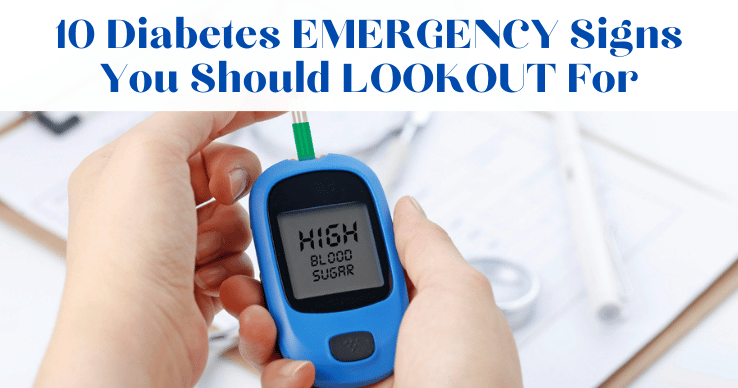Diabetes, a chronic condition affecting millions worldwide, is often accompanied by various symptoms that, if ignored, can escalate into severe health emergencies.
Recognizing these signs early can be the difference between effective management and serious complications. This article aims to highlight 10 Diabetes Emergency Signs you should be vigilant about for effective diabetes management.

10. Intermittent Fever
Intermittent fever in individuals with diabetes is a critical sign that requires immediate attention. It often indicates underlying health complications directly associated with diabetes. Diabetics are more susceptible to infections due to compromised immune function, making any occurrence of fever particularly concerning.
Causes and Concerns
People with diabetes are three times more likely to die from flu and pneumonia, as these respiratory infections can manifest as intermittent fever. Diabetes can cause changes in blood vessels, reducing blood flow, especially to extremities. This impaired circulation hinders the body’s healing process, increasing the risk of infections that may present with fever.
What to Do
Diabetics experiencing intermittent fever should not dismiss this symptom. Seeking medical advice immediately is crucial, as intermittent fever can be an early warning sign of a serious infection or another health issue exacerbated by diabetes. Proactive management and early intervention are key in preventing further complications and ensuring effective diabetes management.
9. Hearing Changes
Hearing changes in individuals with diabetes are a significant concern, as this group is twice as likely to experience hearing impairments. Prolonged high blood sugar levels can damage the blood vessels and nerves in the inner ear, leading to hearing issues.

Understanding the Link
A study reported in the Annals of Internal Medicine found that adults with diabetes had a 21% prevalence of hearing impairment, compared to just 9% in those without diabetes. This suggests a strong correlation between prolonged high glucose levels and hearing loss.
Preventive Measures
Regular hearing evaluations are recommended for people with diabetes to facilitate early detection and management of hearing loss. Maintaining good blood sugar control is also crucial in preserving hearing and overall quality of life.

8. Irregular Breathing Patterns
Irregular breathing patterns in individuals with diabetes, particularly those with Type 1 diabetes, can be a critical warning sign of diabetic ketoacidosis (DKA), a severe and potentially life-threatening complication.
Recognizing Ketoacidosis
DKA predominantly affects people with Type 1 diabetes but can also occur in Type 2 diabetes under certain conditions, such as severe illness or stress. Symptoms include rapid, deep breathing, often described as “Kussmaul respiration.” DKA leads to high blood sugar levels and the production of ketones.
Immediate Steps
Immediate medical attention is crucial in cases of suspected DKA. The condition can escalate quickly, leading to severe outcomes like coma or death. The Centers for Disease Control and Prevention report over 188,000 hospitalizations annually in the U.S. due to DKA, highlighting the seriousness of this condition.
Diet’s Influence on Diabetes
The impacts of diabetes on different aspects of health, including hearing, emphasize the crucial role of overall diabetes management. This includes dietary choices, such as the ketogenic diet and its induced state, ketosis. While ketosis can be part of effective diabetes management, it requires careful monitoring in diabetics. Personalized dietary advice from healthcare professionals is essential, considering the significant implications of dietary choices for both diabetes management and overall health. Debunking myths around diets and diabetes and emphasizing the need for individualized guidance are vital steps in managing diabetes effectively.
7. Skin Changes
Skin changes are a critical indicator in diabetes and its precursor, prediabetes. Conditions like Acanthosis Nigricans, characterized by dark, velvety patches often found in body folds, signal insulin resistance, a vital precursor to diabetes. In diabetes, these skin changes can escalate in severity, marking them as emergency signs.

Types of Skin Changes and Their Significance
- Acanthosis Nigricans: Occurs in about 74% of those with type 2 diabetes, indicating insulin resistance.
- Diabetic Dermopathy (“Shin Spots”): Caused by changes in blood vessels and signals poor circulation, a serious diabetes complication.
- Other Changes: Include dryness, discoloration, or infections resulting from altered blood circulation and sugar levels.
Skin Care Tips
- Recognize early signs like Acanthosis Nigricans and diabetic dermopathy.
- Maintain good skincare routines and control blood sugar levels.
- Regular check-ups with a healthcare provider are crucial for early detection and treatment.

6. Muscle Cramps
Muscle cramps in diabetics, affecting about 25% of individuals, can indicate underlying issues such as electrolyte imbalances, nerve damage, or circulation problems, exacerbated by uncontrolled blood sugar levels.
Understanding Muscle Cramps
- Severe Cramps: Can signal dangerously altered body chemistry or acute diabetic complications like diabetic ketoacidosis or hypoglycemia.
- Electrolyte Imbalance and Nerve Damage: Often a result of prolonged high blood sugar levels.
Managing Cramps
- Recognize when cramps require urgent medical attention.
- Maintain a balanced and individualized diet.
- Stay hydrated and consider gentle stretching exercises.
- Immediate medical consultation is vital in emergency situations.
5. Altered Taste Sensation
Altered taste sensation, or dysgeusia, affecting 5-7% of diabetics, can be an emergency warning sign when it leads to significant changes in eating habits, potentially impacting blood sugar control.

Impact on Nutrition and Health
- Sudden changes in taste can lead to reduced food intake or inappropriate food choices, causing nutritional deficiencies or uncontrolled blood sugar levels.
- In severe cases, changes in taste perception can indicate neurological issues or infections, more common and serious in individuals with diabetes.
Dietary Adjustments and Medical Attention
- Regular monitoring and adjustments to diabetes management plans are crucial.
- In emergency scenarios, immediate medical attention is necessary to determine if these changes are symptoms of larger, potentially life-threatening diabetic complications.
- Working with a dietician can help adjust diets to suit changing tastes while ensuring proper nutrition.

4. Heat Intolerance in Diabetics
Heat intolerance in diabetics is a condition where the body struggles to regulate its temperature effectively. This issue can lead to serious heat-related illnesses, such as heat exhaustion or heat stroke, if not managed with proper hydration and rest.
Understanding the Mechanism
In diabetics, high blood sugar levels can impair the body’s ability to sweat, which is crucial for cooling down. This impairment makes individuals with diabetes more susceptible to heatstroke and other heat-related illnesses.
Key Strategies for Managing Heat Intolerance
To manage heat intolerance, it’s important for diabetics to stay in cooler environments, drink plenty of fluids, and avoid strenuous activities in hot weather. These measures are vital to prevent the body from overheating and to avoid the complications that can arise from heat intolerance.
3. Mood Swings in Diabetics
Mood swings in diabetics are often linked to fluctuating blood sugar levels, which can significantly impact brain function. Recognizing and addressing these mood changes is crucial for maintaining mental health and overall well-being in individuals with diabetes.

The Impact of Blood Sugar on Mood
Both high and low blood sugar levels can affect mood and cognitive function in diabetics. These fluctuations can manifest as irritability, sadness, or even depression, which can be distressing for the individual.
Approaches to Managing Mood Swings
Regular monitoring of blood sugar levels is essential for managing mood swings. Additionally, seeking counseling or therapy can be beneficial. Building a strong support system, including family, friends, and healthcare providers, is also crucial for individuals facing these challenges.

2. Tinnitus in Diabetics
Tinnitus, or ringing in the ears, can be particularly distressing for diabetics. It often indicates underlying issues related to diabetes, such as nerve damage, which can be caused by high blood sugar levels.
The Connection Between Diabetes and Tinnitus
Diabetes can lead to damage in the nerves and blood vessels, which in turn can result in conditions like tinnitus. This issue is often an overlooked complication of diabetes but can significantly impact the quality of life of those affected.
Managing Tinnitus Effectively
While there is no cure for tinnitus, effectively managing diabetes can help reduce its impact. Working with a specialist, exploring techniques like sound therapy, and ensuring overall good health can be beneficial strategies for those experiencing tinnitus as a complication of diabetes.
1. Swollen Gums in Diabetics
Swollen gums in individuals with diabetes are a symptom that should not be overlooked, as it can be a critical indicator of more serious diabetes complications. This condition is more than just a dental health issue; it’s a potential sign of advanced gum disease or periodontitis, which is alarmingly prevalent in the diabetic population.

The Link Between Diabetes and Swollen Gums
- Increased Risk of Gum Disease: Research indicates that people with diabetes are three times more likely to develop periodontal disease than those without diabetes.
- High Blood Sugar and Infection: Elevated blood sugar levels create an environment conducive to infections, including gum infections, making diabetics more susceptible to periodontal disease.
- Impact on Overall Health: Periodontitis in diabetics can worsen blood sugar control, creating a cycle that exacerbates both the gum disease and diabetes.
Understanding the Severity
- Rapid Progression: Periodontitis in diabetics often progresses more rapidly and can be more severe compared to non-diabetics.
- Associated Health Risks: A study in the “Journal of Periodontology” reported that diabetics with periodontitis have a higher risk of developing cardiovascular complications and kidney disease.
Preventive Oral Care and Treatment
- Regular Oral Hygiene: Regular brushing, flossing, and dental check-ups are crucial in preventing gum disease.
- Professional Dental Care: Discussing specific care for diabetes-related oral health issues with a dentist is important.
- Prompt Intervention: Swollen gums in a diabetic should be addressed immediately with dental and medical intervention. Early treatment can prevent the progression of gum disease and mitigate its impact on overall diabetes management.
The Broader Implications
Swollen gums in diabetics serve as a reminder of the interconnected nature of health. Oral conditions can significantly influence systemic diseases like diabetes. Therefore, it’s essential to view swollen gums not just as an oral health issue but as a potential indicator of broader health challenges related to diabetes. Recognizing and addressing this symptom early can play a crucial role in the effective management of diabetes and its related complications.
Prevention and Management
Effectively managing diabetes involves a comprehensive approach that encompasses lifestyle changes, regular monitoring, and proactive healthcare. The goal is to not only manage blood sugar levels but also to prevent the onset of complications that can arise from poorly controlled diabetes.
Lifestyle Modifications
- Diet: A balanced diet rich in nutrients, low in processed sugars and unhealthy fats is crucial. Incorporating whole grains, lean proteins, and plenty of fruits and vegetables can make a significant difference.
- Exercise: Regular physical activity helps in maintaining a healthy weight and improves insulin sensitivity. A mix of aerobic exercises and strength training is often recommended.
- Stress Management: High levels of stress can adversely affect blood sugar levels. Practices like meditation, yoga, or even regular leisure activities can help in stress reduction.
Regular Health Check-Ups
- Blood Sugar Monitoring: Keeping a close check on blood sugar levels is essential. This includes regular self-monitoring and A1C tests at the doctor’s office.
- Regular Medical Appointments: Regular appointments with a healthcare provider are important to monitor the overall health status and make necessary adjustments in the diabetes management plan.
Proactive Health Care
- Screenings for Complications: Regular screenings for potential diabetes-related complications such as retinopathy, neuropathy, and kidney function tests should be a part of the healthcare routine.
- Vaccinations: Staying up to date with vaccinations, like the flu vaccine, can prevent infections that are particularly risky for diabetics.
Vigilance is Key
Understanding and recognizing the emergency signs of diabetes is crucial for effective management and preventing serious complications. It’s essential for individuals with diabetes, as well as their caregivers, to stay informed and vigilant about the various symptoms and changes in health that could indicate underlying issues.
For a more in-depth understanding of diabetes emergency signs and its management, I highly recommend watching this video.





